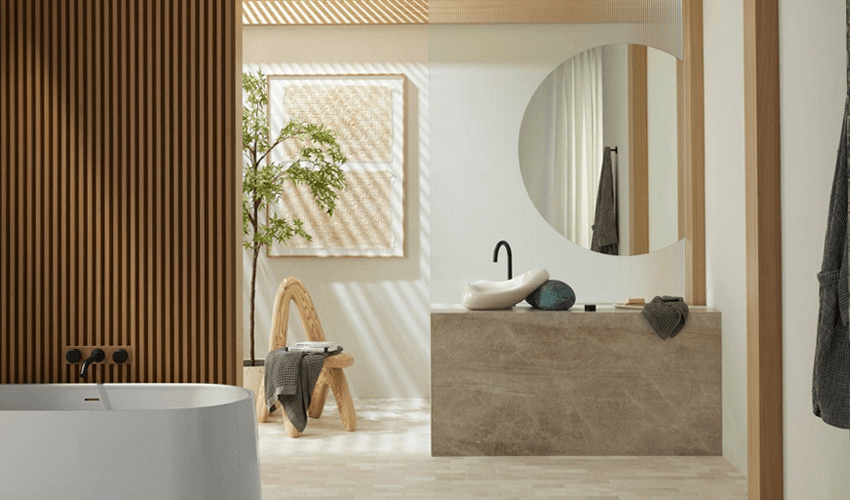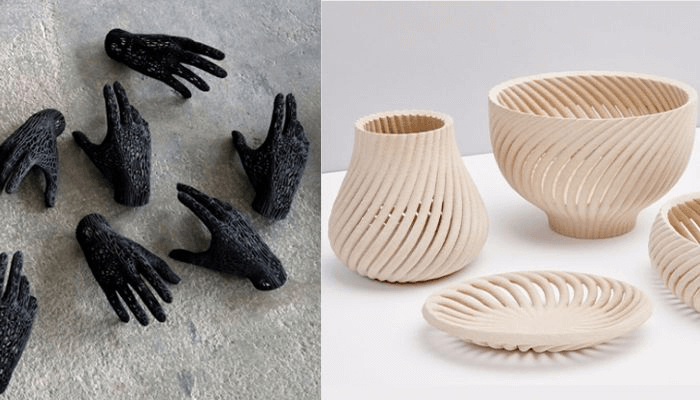
As we see 3D printing being used in more and more industrial sectors, the question remains: what role does it play in everyday life? Can it affect our daily environment? Looking at the use of 3D printing in interior design, the possibilities offered by 3D technologies are clear. When they first came into use, polymers were mostly preferred, but advances in research and development have allowed for significant changes in this area. For example, materials such as sand, wood or marble are becoming increasingly popular. Indeed, in this sector, creativity reigns supreme and that is why 3D printing is the ideal option, as it gives free rein to the imagination. Here we look at how this synergy between additive manufacturing and creativity is taking hold in the field of design and architecture.
Interior design is the discipline of shaping the experience of interior space. This is done by manipulating spatial volume and surfaces. It can be present in all areas of the home, including bathrooms, kitchens, living rooms and bedrooms. Meanwhile, objects that can be 3D printed for interior design purposes include furniture, chairs, tables, lamps, bathroom accessories, decorative items, and more. The variety of items that can give your home the touch and detail you crave is wide. In addition, the use of additive manufacturing can increase both sustainability and customization in home projects.

3D printed sink made of sand (photo: Sandhelden)
The advantages of 3D printing in interior design
One of the advantages of additive manufacturing is the ease with which you can design almost any part imaginable; 3D printing offers design freedom with very few limitations. And you don't have to be a maker to take advantage of this – even those who have a 3D printer at home benefit from it! Other advantages of 3D printing in interior design include the ability to print large volumes on XXL machines, as well as small and medium runs, all with flexibility and speed.
Sandhelden, for example, is a German company that uses 3D printing to design bathroom furniture. "We are not subject to minimum order quantities. On the largest printer, we can print around 150 wash basins in less than 24 hours. So it doesn't matter if all the sinks are identical or each one is a slightly different size,” they explain. Another aspect that also characterizes 3D printing is its commitment to the environment, but we will return to this in more detail later.
Which 3D technologies are used in interior design?
There are many different printing processes and no single technology is best suited for interior design. To choose the right one, you need to consider a number of aspects, such as the desired finish, the compatible material or the end application. Looking more closely at the market and its players, more and more companies are integrating additive manufacturing into their production chains. The famous Swedish brand IKEA is one of the companies that embraced 3D printing a few years ago. His first collection of 3D-printed objects was created in 2018 with SLS printing, in collaboration with designer Bea Åkerlund. The project of the London studio Alaska is another example: thanks to SLS, they have built a table whose legs are 3D printed and can withstand the weight of a walnut tabletop.
Another technology used is binder jetting. It is compatible with a wide variety of materials, including metal, sand, wood, ceramic and composites. One of the companies already using it for interior design is Sandhelden, especially for the creation of bathroom collections. Another example is Forust. Founded in 2019, the company uses wood as a material to produce decorative pieces, among other applications. It also offers its customers an online printing service where anyone can order samples or submit their creations. By applying colors and textures to 3D printed sawdust, it opened up a wide range of functional and creative possibilities. Since their partnership with Desktop Metal, the two companies have used binder jetting on metal dust and wood waste for a number of sustainable projects.

On the left, IKEA's first project using SLS technology, and on the right, Forust CCorporation's project using Desktop Metal.
FDM technology can also be used, a very affordable option with which you can produce your own 3D part at home, since these printers are available on the market from around a hundred euros. The materials you can use are mostly thermoplastics such as PLA, ABS, Polyamide or PETG. Some of the projects that use this technology are, for example, chairs with a puzzle-like design created by Bits & Parts, which you can find in 3 different models.
Which materials are most commonly used?
In order to choose the right material for your decorative piece, there are several factors to consider. These include the properties of the material (flexibility, strength, etc.), the color or type of use, and the finish, among others. The most commonly used materials in 3D printing are polymers and metals, which you can find in different forms: resin, filament or powder, depending on the technology you choose. Polymers, for example, can be used for a wide variety of parts and decorative objects.
Ceramics and organic materials can also give your room a real, natural look. For example, you can use wood for lamps or other materials such as glass or stone for tableware. We also mentioned sand above. You can also use clay, a material that will give your pieces a smooth and hard finish. In the picture below you can see some examples of parts 3D printed with this material palette.

1. Ceramic and organic materials; 2. Stone cutlery; 3. Sand; 4. Glass
The role of sustainability
Many companies pay particular attention to environmental protection, not only through 3D printed homes, but also by using this technology in other areas of design. In addition, there are many projects where 3D printing and recycling go hand in hand. For example, Barbara Gollackner transformed food waste into 3D printed dinnerware, or a 3D printed pavilion was made in the Middle East from recycled water bottles.
But it goes further than that. 3D printing can be considered increasingly efficient because, in addition to allowing the creation of objects in a short time, it uses only the necessary amount of material, thus not producing as much waste as traditional production. Bold design , another interior design company, explains: “When we create products for mass production, 3D printing allows us to produce objects as close as possible to the end users. We limit storage by producing in small batches, on demand, without necessarily increasing costs, unlike injection molding processes that require expensive and complex tooling. By mastering the design for 3D printing, we are able to manage both the aesthetic aspect and the highly technical elements within the same part, limiting human intervention, making it possible to obtain precise, high-quality objects at very reasonable prices, customization them and care for the environment."
Other projects worth mentioning include the construction of a 3D printed staircase wall. Produced by the Institute of Advanced Architecture of Catalonia (IAAC), it is made of rice and clay, an environmentally sustainable material. Another outdoor project is pots made from 100% recycled plastic from Aectual. Hans Vermeulen, Co-Founder and CEO, said: “It is also a raw material with which we can make beautiful things, thanks to the new craft of 3D printing. We want to help make the polluting world of construction cleaner and more beautiful. It all starts small with this planter.”
Last but not least there is furniture. The production of furniture through 3D printing is particularly interesting from an environmental point of view. You can use 100% recycled plastic or recycle municipal waste for example. R3direct, for example, prints plastic in granular form, thus requiring less energy and emitting less CO2. The granules come from recycled packaging (bottles and fruit juice cartons).

To the left you can see the wall and staircase made of clay and rice; right, the R3direct ecological bench
Additive manufacturing and customization
One of the great advantages of additive manufacturing is its capacity for customization. Home decorating is a very personal thing, and tastes and colors are non-negotiable. 3D printing allows you to do just that, customize your home furnishings. This is because 3D printing allows users to create designs that they have always imagined but never been able to realize as it gives free rein to imagination and creativity.
It is even possible for users to do it themselves with their own 3D printer. We have already seen examples of lamps, decorative objects such as vases, pots or even chairs, furniture, etc. Let your imagination run wild and integrate 3D printed objects into your home! If you have 3D design skills, you can modify or redesign the rooms you want in your home. There are a number of software programs you can use to create these designs, or you can even find them already produced on various online file platforms.
What does the future hold for 3D printing in interior design?
We analyzed and learned a little more about the role of 3D printing in interior design. But what does the future hold for this sector? Almost every industry now uses additive manufacturing in their manufacturing process, thanks to the many advantages it offers. From designers to large companies, they see a great market opportunity where they can develop great freedom in designing, manufacturing and marketing their products. The wide variety of materials available on the market and compatible with 3D technologies means that an infinite number of parts can be created, from small highly detailed objects to furniture, decorative elements, cutlery, etc. It is only a matter of time before new companies and projects dedicated to interior design through 3D printing appear. We hope that in the future we will continue to see design projects that stand out for their personalization and originality or for their commitment to the environment. We'll keep you posted on any new developments, so stay tuned!
0 Comments